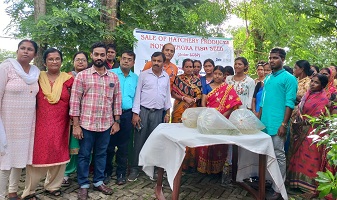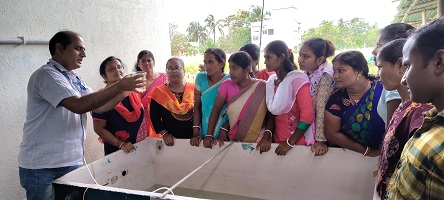Bengal Catfish (Mystus gulio (Ham.) locally known as “nona tengra” is a commercially important small indigenous fish species (SIS) of the Sundarban delta. A group of landless Scheduled Caste farm women from village - Buddhapur, District - South 24 Parganas, West Bengal adopted homestead hatchery-cum-seed production technology developed by the Kakdwip Research Centre of ICAR-Central Institute Brackishwater Aquaculture, Chennai

The components of the modular hatchery units are broodstock development (pond cage), breeding unit (FRP tank: 1000 L with provision of water flow) and larval rearing unit. KRC-CIBA provided the women a three-day ‘hands on training’ on the seed production of M. gulio at its centre, Kakdwip. The seed production protocols include: selection of mature and healthy brood fish (male: female-2:1), maturity assessment, placement of egg collector in the breeding tank, administration of hormone, observation of spawning after 8-12 h of injection, collection of eggs, egg incubation-hatching, larval rearing and nursery.

The women group produced 20,000 M. gulio fry (seed) and sold thirty days old nursery reared seed of M. gulio to fish farmers of Sagar Island, Namkhana and Kakdwip, West Bengal at the rate of ₹ 1.00/fry and the profit was ₹. 10,400 per month by spending hardly two hours of their leisure time at home itself.
This technology not only met the high demand for the fish seed but importantly prevented the seed collection from the natural stock. Therefore, this model proved to be an economically viable and may be promoted as a livelihood option for the landless poor in the Sunderbans region of west Bengal.
(Source: ICAR-Central Institute Brackishwater Aquaculture, Chennai)








Like on Facebook
Subscribe on Youtube
Follow on X X
Like on instagram